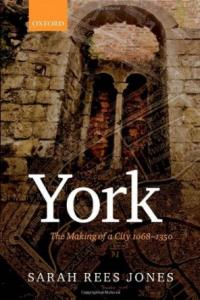York. The Making of a City 1068-1350
CODICE: ISBN 019820194X EAN 9780198201946
AUTORE/CURATORE/ARTISTA :
Author: Sarah Rees Jones
EDITORE/PRODUTTORE : Oxford University Press
COLLANA/SERIE :
DISPONIBILITA': Disponibile
TITOLO/DENOMINAZIONE:
York. The Making of a City 1068-1350
PREZZO : EUR 100,00€
CODICE :
ISBN 019820194X
EAN 9780198201946
AUTORE/CURATORE/ARTISTA :
Author: Sarah Rees Jones
EDITORE/PRODUTTORE:
Oxford University Press
ANNO:
2013
DISPONIBILITA':
Disponibile
CARATTERISTICHE TECNICHE:
416 pages
17 black and white maps
Hardback
cm 15,6 x 23,4
gr 780
DESCRIZIONE:
Publisher's description:
First book-length study of York between 1068 and 1350
Provides a new interpretation of the impact of the Norman Conquest on English towns
Presents new evidence for the polyfocal character of York and the integration between town and country
Argues for the fundamental importance of new lay enthusiasm over urban saints cults to the development of civic government in medieval English towns
Reassesses the evidence for a change in opportunities for women in towns over the fourteenth century
York was one of the most important cities in medieval England. This original study traces the development of the city from the Norman Conquest to the Black Death. The twelfth and thirteenth centuries are a neglected period in the history of English towns, and this study argues that the period was absolutely fundamental to the development of urban society and that up to now we have misunderstood the reasons for the development of York and its significance within our history because of that neglect.
Medieval York argues that the first Norman kings attempted to turn the city into a true northern capital of their new kingdom and had a much more significant impact on the development of the city than has previously been realised. Nevertheless the influence of York Minster, within whose shadow the town had originally developed, remained strong and was instrumental in the emergence of a strong and literate civic communal government in the later twelfth and thirteenth centuries. Many of the earlier Norman initiatives withered as the citizens developed their own institutions of government and social welfare.
The primary sources used are records of property ownership and administration, especially charters, and combines these with archaeological evidence from the last thirty years. Much of the emphasis of the book is therefore on the topographical development of the city and the changing social and economic structures associated with property ownership and occupation.
Table of contents:
Acknowledgements
Abbreviations
1: Introduction
2: Landscapes of Lordship at the time of the Conquest: The Minster, the King, and the Earl
3: Landscapes of Lordship on the Eve of the Conquest: Lesser Landowners and their Urban Estates
4: The King, the Barons, and the Shire
5: Church Landlords
6: Householders, Civic Society, and Civic Government
7: Town and Country: Trade, Fairs, Markets, and Festivals
8: Domestic Property
9: Conclusion
Bibliography
GENERE: Libri ,Monografie ,



